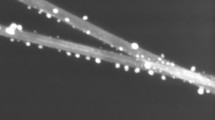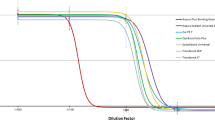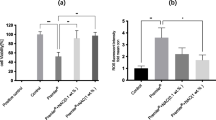Abstract
Toxicity potentiation of two monomers [bisphenol-A-glycidyldimethacrylate (BisGMA) and urethanedimethacrylate (UDMA)] as well as two comonomers [triethyleneglycoldimethacrylate (TEGDMA) and 2-hydroxyethylmethacrylate (HEMA)], each in combination with H2O2, was investigated on the viability on human gingival fibroblasts (HGF) and human pulpal fibroblasts (HPF). The applied concentration of H2O2 was 0.06 or 0.1 mmol/l, respectively, corresponding to the EC0 of H2O2 in HGF or HPF. The cell viability was assessed by the XTT test. From this test the half maximum effect concentrations (EC50) were calculated from fitted sigmoidale curves. EC50 values were (HGF; mmol/l; mean ± s.e.m.; n = 5): HEMA 11.9 ± 0.9, TEGDMA 3.7 ± 0.3, H2O2 0.36 ± 0.04, UDMA 0.27 ± 0.08, and BisGMA 0.11 ± 0.03. No significant (P < 0.05) differences in the EC50 values were observed when HGF was exposed to substances, as compared to HPF. No significant decrease of the EC50 values was found when HGF or HPF, respectively, was exposed to HEMA or BisGMA in addition with H2O2 up to the concentration of 0.1 mmol/l, as compared to those EC50 values of each compound without H2O2 addition. A significant decrease of the TEGDMA EC50 value from 3.7 to 2.1 or 0.4 mmol/l, respectively, was found when cells were exposed to TEGDMA in combination with H2O2 (0.06 or 0.1 mmol/l), as compared to that TEGDMA EC50 value without H2O2 addition. A significant decrease of the UDMA EC50 value from 0.27 to 0.11 or 0.08 mmol/l, respectively, was found when HGF or HPF was exposed to UDMA in combination with H2O2 (0.06 or 0.1 mmol/l), as compared to that UDMA EC50 value without H2O2 addition. The addition of H2O2 (0.06 or 0.1 mmol/l) resulted in a toxicity potentiation of TEGDMA and UDMA, but not of HEMA and BisGMA, on HGF or HPF.



Similar content being viewed by others
References
Al-Hiyasat AS, Darmani H, Milhem MM (2005) Cytotoxicity evaluation of dental resin composites and their flowable derivatives. Clin Oral Investig 9:21–25
Ali I, Aboul-Enein H, Ghanem A (2005) Enantioselective toxicity and carcinogenesis. Curr Pharm Anal 1:109–125
Bouillaguet S, Wataha J, Hanks C, Ciucchi B, Holz J (1996) In vitro cytotoxicity and dentin permeability of HEMA. J Endod 22:244–248
Cavalcanti B, Rode S, Marques M (2005) Cytotoxicity of substances leached or dissolved from pulp capping materials. Int Endond J 38:505–509
Cuttle L, Zhang X, Endre Z, Winterford C, Gobe G (2001) Bcl-X-L translocation in renal tubular epithelial cells in vitro protects distal cells from oxidative stress. Kidney Int 59:1779–1788
Datar R, Rueggeberg F, Caughman G, Wataha J, Lewis J, Schuster G (2004) Effects of subtoxic concentrations of benzoyl peroxide on cell lipid metabolism. J Biomed Mater Res A 71:685–692
Engelmann J, Janke V, Volk J, Leyhausen G, Von Neuhoff N, Schlegelberger B, Geurtsen W (2004) Effects of BisGMA on glutathione metabolism and apoptosis in human gingival fibroblasts in vitro. Biomaterials 25:4573–4580
Engelmann J, Volk J, Leyhausen G, Geurtsen W (2005) ROS formation and glutathione levels in human oral fibroblasts exposed to TEGDMA and camphorquinone. J Biomed Mater Res B Appl Biomater 75:272–276
Ferracane JL (1994) Elution of leachable components from composites. J Oral Rehabil 21:441–452
Ferracane JL, Condon JR (1990) Rate of elution of leachable components from composite. Dent Mater 6:282–287
Forst HT (1985) Probleme des multiplen Testens und Schätzens in der Arzneimittelforschung. Arzneim Forsch/Drug Res 35:3–5
Fugaro J, Nordahl I, Fugaro O, Matis B, Mjor I (2004) Pulp reaction to vital bleaching. Oper Dent 29:363–368
Gerzina TM, Hume WR (1996) Diffusion of monomers from bonding resin-resin composite combinations through dentine in vitro. J Dent 24:125–128
Geurtsen W, Leyhausen G (2001) Chemical–biological interactions of the resin monomer triethyleneglycol-dimethacrylate (TEGDMA). J Dent Res 80:2046–2050
Haywood VB, Heymann HO (1989) Nightguard vital bleaching. Quintessence Int 20:173–177
Hegedus C, Bistey T, Flora-Nagy E, Keszthelyi G, Jenei A (1999) An atomic force microscopy study on the effect of bleaching agents on enamel surface. J Dent 27:509–515
Heil J, Reifferscheid G, Waldmann P, Leyhausen G, Geurtsen W (1996) Genotoxicity of dental materials. Mutat Res 368:181–194
Jones T, Henderson J, Johnson R (2005) Effects of doxorubicin on human pulp cells in vitro. Cell Biol Toxicol 21:207–214
Kedjarune U, Charoenworaluk N, Koontongkaew S (1999) Release of methyl methacrylate from heat-cured and autopolymerized resins: cytotoxicity testing related to residual monomer. Aust Dent J 44:25–30
Kehe K, Reichl FX, Durner J, Walther U, Hickel R, Forth W (2001) Cytotoxicity of dental composite components and mercury compounds in pulmonary cells. Biomaterials 22:317–322
Kleinsasser NH, Wallner BC, Harreus UA, Kleinjung T, Folwaczny M, Hickel R, Kehe K, Reichl FX (2004) Genotoxicity and cytotoxicity of dental materials in human lymphocytes as assessed by the single cell microgel electrophoresis (comet) assay. J Dent 32:229–234
Lai YL, Yang ML, Lee SY (2003) Microhardness and color changes of human dentin with repeated intracoronal bleaching. Oper Dent 28:786–792
Lee S, Yoon Y, Jang YY, Song JH, Han ES, Lee CS (2001) Effect of iron and ascorbate on cyclosporine-induced oxidative damage of kidney mitochondria and microsomes. Pharmacol Res 43:161–171
Lefeuvre M, Amjaad W, Goldberg M, Stanislawski L (2005) TEGDMA induces mitochondrial damage and oxidative stress in human gingival fibroblasts. Biomaterials 26:5130–5137
Lonnroth EC, Shahnavaz H (1997) Use of polymer materials in dental clinics, case study. Swed Dent J 21:149–159
Mathias CGT, Caldwell TM, Maibach HI (1979) Contact-dermatitis and gastro-intestinal symptoms from hydroxyethylmethacrylate. Br J Dermatol 100:447–449
Mazzaoui SA, Burrow MF, Tyas MJ (2002) Long-term quantification of the release of monomers from dental resin composites and a resin-modified glass ionomer cement. J Biomed Mater Res 63:299–305
Nakabayashi N, Takarada K (1992) Effect of Hema on bonding to dentin. Dent Mater 8:125–130
Ratanasathien S, Wataha JC, Hanks CT, Dennsion JB (1995) Cytotoxic interactive effects of dentin bonding components on mouse fibroblasts. J Dent Res 74:1602–1606
Reichl FX, Durner J, Hickel R, Kunzelmann KH, Jewett A, Wang MY, Spahl W, Kreppel H, Moes GW, Kehe K, Walther U, Forth W, Hume WR (2001) Distribution and excretion of TEGDMA in guinea pigs and mice. J Dent Res 80:1412–1415
Reichl F, Durner J, Kehe K, Folwaczny M, Kleinsasser N, Schwarz M, El-Mahdy K, Hickel R (2003) Synergistic effects of H2O2 with components of dental restorative materials on gluconeogenesis in rat kidney tubules. Biomaterials 24:1909–1916
Rueggeberg FA, Caughman WF (1993) The influence of light exposure on polymerization of dual-cure resin cements. Oper Dent 18:48–55
Salahudeen AK, Huang H, Patel P, Jenkins JK (2000) Mechanism and prevention of cold storage-induced human renal tubular cell injury. Transplantation 70:1424–1431
Sasaki N, Okuda K, Kato T, Kakishima H, Okuma H, Abe K, Tachino H, Tuchida K, Kubono K (2005) Salivary bisphenol-A levels detected by ELISA after restoration with composite resin. J Mater Sci Mater Med 16:297–300
Schweikl H, Schmalz G (1997) Glutaraldehyde-containing dentin bonding agents are mutagens in mammalian cells in vitro. J Biomed Mater Res 36:284–288
Schwengberg S, Bohlen H, Kleinsasser N, Kehe K, Seiss M, Walther UI, Hickel R, Reichl FX (2005) In vitro embryotoxicity assessment with dental restorative materials. J Dent 33:49–55
Scudiero DA, Shoemaker RH, Paull KD, Monks A, Tierney S, Nofziger TH, Curren MJ, Seniff D, Boyd MR (1988) Evaluation of a soluble tetrazolium formazan assay for cell-growth and drug sensitivity in culture using human and other tumor-cell lines. Cancer Res 48:4827–4833
Seiss M, Kehe K, Haffner C, El-Mahdy K, Hickel R, Nitz S, Walther UI, Manhart J, Reichl FX (2004) Analytic of (toxic) intermediates from metabolized dental restorative materials. Naunyn Schmiedebergs Arch Pharmacol 369:R107
Seiss M, Nitz S, Kleinsasser N, Buters J, Behrendt H, Hickel R, Reichl F (2007) Identification of 2,3-epoxymethacrylic acid as an intermediate in the metabolism of dental materials in human liver microsomes. Dent Mater 23:9–16
Sofou A, Tsoupi I, Emmanouil J, Karayannis M (2005) HPLC determination of residual monomers released from heat-cured acrylic resins. Anal Bioanal Chem 381:1336–1346
Spahl W, Budzikiewicz H, Geurtsen W (1998) Determination of leachable components from four commercial dental composites by gas and liquid chromatography mass spectrometry. J Dent 26:137–145
Stanislawski L, Lefeuvre M, Bourd K, Soheili-Majd E, Goldberg M, Perianin A (2003) TEGDMA-induced toxicity in human fibroblasts is associated with early and drastic glutathione depletion with subsequent production of oxygen reactive species. J Biomed Mater Res A 66A:476–482
Terasaka H, Kadoma Y, Sakagami H, Fujisawa S (2005) Cytotoxicity and apoptosis-inducing activity of bisphenol A and hydroquinone in HL-60 cells. Anticancer Res 25:2241–2247
Volk J, Leyhausen G, Dogan S, Geurtsen W (in press) Additive effects of TEGDMA and hydrogen peroxide on the cellular glutathione content of human gingival fibroblasts. Dent Mater
Walther UI, Siagian II, Walther SC, Reichl FX, Hickel R (2004) Antioxidative vitamins decrease cytotoxicity of HEMA and TEGDMA in cultured cell lines. Arch Oral Biol 49:125–131
Yao HR, Richardson DE (2000) Epoxidation of alkenes with bicarbonate-activated hydrogen peroxide. J Am Chem Soc 122:3220–3221
Acknowledgments
This work has been supported by the Deutsche Forschungsgemeinschaft (DFG), Germany; number RE 633/2-1/4. The authors gratefully acknowledge the excellent technical assistance of Sabine Domes and Stefan Schulz.
Author information
Authors and Affiliations
Corresponding author
Rights and permissions
About this article
Cite this article
Reichl, FX., Seiss, M., Marquardt, W. et al. Toxicity potentiation by H2O2 with components of dental restorative materials on human oral cells. Arch Toxicol 82, 21–28 (2008). https://doi.org/10.1007/s00204-007-0226-1
Received:
Accepted:
Published:
Issue Date:
DOI: https://doi.org/10.1007/s00204-007-0226-1




